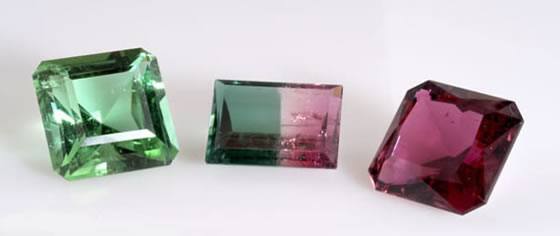Gemstones have been produced in what is now the United States for
thousands of years. Native Americans produced
turquoise, flint, amber, shells, obsidian and other materials for use in
jewelry, beads, carvings and tools. In the southwest they mined
turquoise and used it to make earrings and pendants. Along the Atlantic
and Gulf coasts shells were used as gemstones and ornaments. The use of
flint for making tools and ornaments was widespread.

The
first commercial gemstone mine in the United States that was operated
by miners other than Native Americans was at Mount Mica, Maine. There a
large deposit of tourmaline was discovered by two boys in 1820. Two
years later a mine was opened which has yielded thousands of carats of
gem quality crystals. The three cut tourmalines above are from the
Dunton
Quarry, Newry, Oxford County, Maine (left 29.67 carats, middle
20.01 carats, right 27.43 carats). Photo by Thuss Photography. Used with
permission of the Maine State Museum.
|
Native Americans produced gemstone materials, used them locally and
sometimes traded them across great distances. Obsidian can be used as
evidence of this trade. It is a volcanic glass that is available in
limitad areas; however, it was used in tools and ornaments by Native
Americans throughout North America. This wide distribution is evidence
of a significant trade in obsidian.
What Gemstones Are Mined in the United States?
About 60 types of gemstones have been produced in the United States. The
most important gemstones in current production include:
agates, amber, beryl, coral, garnet, jade, jasper, opal, pearls, peridot, quartz, sapphire, shell, topaz, tourmaline, turquoise and others. These stones are used for jewelry, carvings and as specimens by gem and mineral collectors
